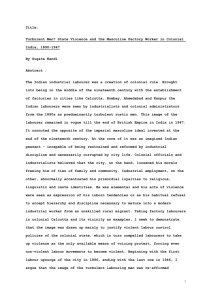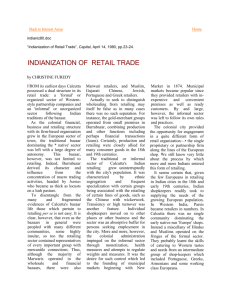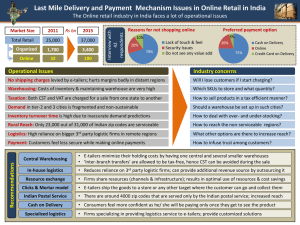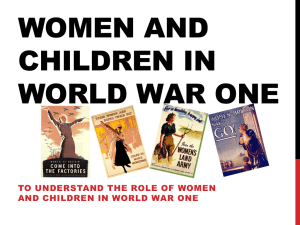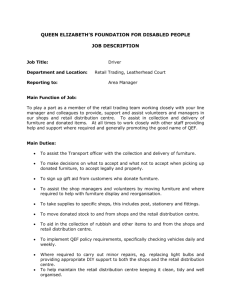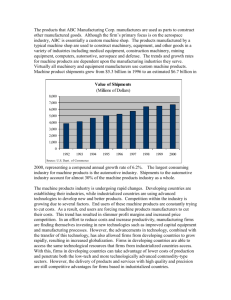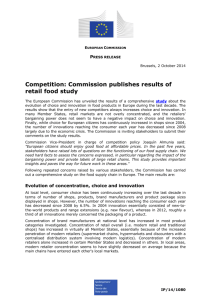Development of modern elite retailing in Eastern
advertisement
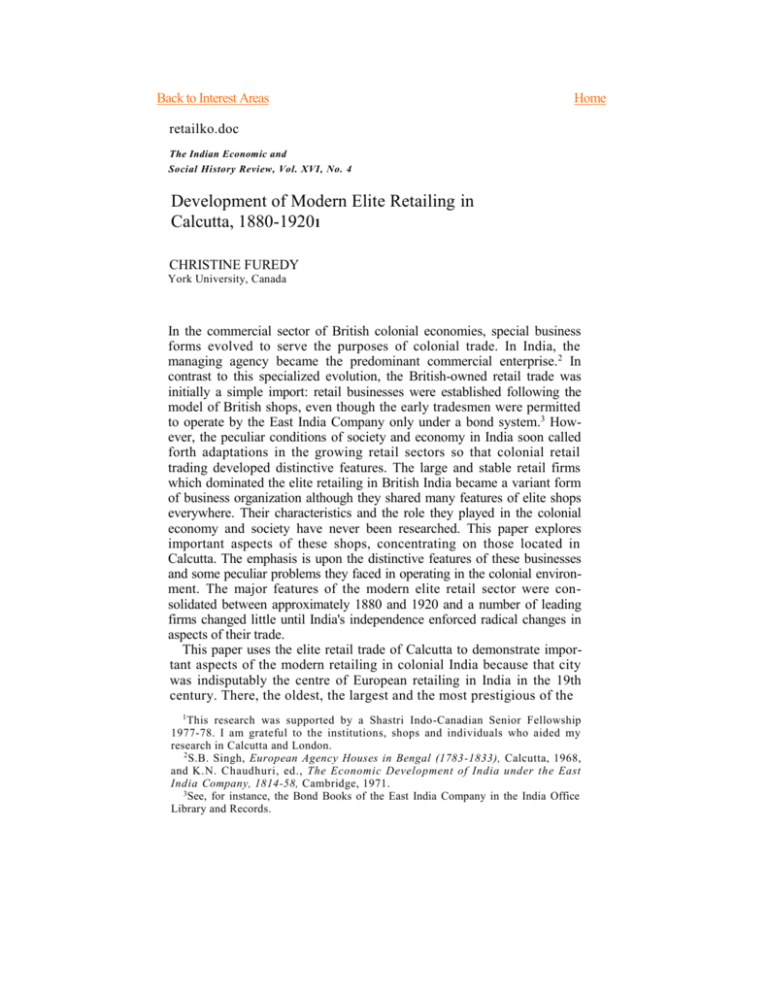
Back to Interest Areas Home retailko.doc The Indian Economic and Social History Review, Vol. XVI, No. 4 Development of Modern Elite Retailing in Calcutta, 1880-19201 CHRISTINE FUREDY York University, Canada In the commercial sector of British colonial economies, special business forms evolved to serve the purposes of colonial trade. In India, the managing agency became the predominant commercial enterprise.2 In contrast to this specialized evolution, the British-owned retail trade was initially a simple import: retail businesses were established following the model of British shops, even though the early tradesmen were permitted to operate by the East India Company only under a bond system.3 However, the peculiar conditions of society and economy in India soon called forth adaptations in the growing retail sectors so that colonial retail trading developed distinctive features. The large and stable retail firms which dominated the elite retailing in British India became a variant form of business organization although they shared many features of elite shops everywhere. Their characteristics and the role they played in the colonial economy and society have never been researched. This paper explores important aspects of these shops, concentrating on those located in Calcutta. The emphasis is upon the distinctive features of these businesses and some peculiar problems they faced in operating in the colonial environment. The major features of the modern elite retail sector were consolidated between approximately 1880 and 1920 and a number of leading firms changed little until India's independence enforced radical changes in aspects of their trade. This paper uses the elite retail trade of Calcutta to demonstrate important aspects of the modern retailing in colonial India because that city was indisputably the centre of European retailing in India in the 19th century. There, the oldest, the largest and the most prestigious of the 1 This research was supported by a Shastri Indo-Canadian Senior Fellowship 1977-78. I am grateful to the institutions, shops and individuals who aided my research in Calcutta and London. 2 S.B. Singh, European Agency Houses in Bengal (1783-1833), Calcutta, 1968, and K.N. Chaudhuri, ed., The Economic Development of India under the East India Company, 1814-58, Cambridge, 1971. 3See, for instance, the Bond Books of the East India Company in the India Office Library and Records. 378 CHRISTINE FUREDY predominantly British-owned retail partnership companies held sway over a clientele located in a wide hinterland. Calcutta had a larger and more diversified retail structure than the other colonial cities: three to five wellknown shops in any one line of major business to Bombay's one or two, while Madras had an even more elementary retail structure. The Calcutta retail shops were the "trend setters" for modern retailers throughout the subcontinent. By the middle of the nineteenth century Calcutta's commercial life was stratified into four main sectors: commercial firms, the European retail trade, Indian-owned, modern retail firms, and the bazaar sector of the city's markets and small-scale trade. "Commerce" included the large-scale import/export companies, the managing agencies and a diversity of businesses dealing in wholesale trade; the retail sector was divided mainly between the modern firms based on the British model of the partnership company and the bazaar firms which often displayed a mixture of traditional Indian trade practices and European procedures. The distinction between "European" and Indian firms was more significant for the retail sector than the commercial one. For, while there are instances of Indianmanaged commercial firms and European-Indian partnership4 and while leading Indian merchants participated in the Bengal Chamber of Commerce, the elite retail firms of Calcutta were almost exclusively European for the period considered here, and their organization, the Calcutta Trades Association admitted no Indian firms until a later date. As will be seen, the line between the elite retail firms and the bazaar shops was quite distinct. Further, there was a stratification within the European retail trade. At the top stood the established shops whose business was India-wide (and even wider). They imported their goods or materials from quality suppliers in Britain, Europe and the United States of America; they obtained royal appointments and filled government contracts; their valued clientele comprised the princes and aristocrats of Indian society. Calcutta had, of course, many smaller businesses, often single proprietary companies, whose trade was essentially local. The racial division within the retail trade was obviously a major distinguishing factor in retailing in such a colonial city. All European shopkeepers, no matter how modest their businesses, shared to some extent the elite status of the ruling power and the special privileges which British tradesmen won for themselves in trade. The existence of an almost exclusively Indian bazaar sector also affected the development of the elite European retail trade. There were goods and services which were offered so cheaply 4 See, in particular, Blair B. Kling's Study of Dwarkanath Tagore, Partner in Empire, Berkeley, 1976. Development of Modern Elite Retailing in Calcutta 37 by the bazaar firms that their equivalents were not marketed by elite shops. For instance, fresh food was marketed through the bazaar and Calcutta possessed no European greengrocers or butchers. The effect of the bazaar competition was noted by a visitor to Calcutta as early as 1840: "European tradesmen must be very industrious and methodical and produce excellent workmanship for everyone of them has a host of wouldbe native rivals in the bazaars."5 He added that "even in the streets where Europeans are numerous there are many native dealers; these dealers are very content with a small profit and can live comfortably a whole year on a sum which would not support the European shopkeepers more than a few days."6 In the early days, the European shopkeeper had the advantage of easier access to prized imported goods (even of a prosaic nature) but by the mid-19th century the bazaar was dealing with a wide range of imported manufactured goods. Consequently the European shops became even more exclusive: they did not deal in "cheap lines:" they stressed the quality of their goods and services. Between the extremes of the elite shops and the local market ones ranged a variety of middle-sized businesses which competed, selectively, for a wider market. Some prospered and diversified, edging up into the elite class; most remained at their established level, having a life of only one or two generations of partners. It is only for the elite firms that any significant amount of information can be gathered for the 19th and early 20th centuries. No accurate census of the number of European-owned retail businesses exists for the 19th century, for trade directories cannot be assumed to be complete and records of municipal license fees show only the number of businesses paying certain categories of rates.7 One may estimate that, in the period covered in this discussion, there were between 200 to 250 substantial retail businesses operating in the city. Among them one can distinguish retailers proper, who obtained good in a finished or almost finished state for resale (for instance, drapers, haberdashers, provisioned, hardware merchants, ironmongers, gunmerchants, booksellers and stationers) and producer-retailers or craftsmen-retailers (including watchmakers and jewellers, coach builders, bootmakers and saddlers, tailors and photographers). Also included among retailers were those whose business required a high level of education or training, for instance, chemists and opticians. 5M Griffen, Sketches of Calcutta or Notes of a late Sojourn in the 'City of Palaces', Glasgow, 1843, p. 206. «Ibid. 9 p. 207. 7 The leading directories were those published by Thacker, Spink & Co. Figures for trade licenses issued in Calcutta city are contained in the Municipal Administration Reports of the Corporation of Calcutta, 380 CHRISTINE FUREDY The initial core of European retail development in Calcutta was in the vicinity of Dalhousie Square. For most of the nineteenth century the most prestigious shopping street was Old Court House Street, where even today several of the famous old shops are still to be found. In the first half of the century, there was some European retail development to the north of Dalhousie Square along Lall Bazaar but by 1860 the thrust of new development was southwards along Bentinck St. and into Chowringhee, with elite retailing spreading up Park St. by the 1870s. In some cases old business relocated to more spacious premises; there were also cases of branches being opened in the south of the city as, for instance, Bathgate and Co. (chemists) with their headquarters on Old Court House St., who opened a branch on Park Street. Park Street came into its own when the large department stores located there, taking advantage of the space to design large and impressive premises. Their design showed some of the adaptations which were called for by the Calcutta climate. Hall and Anderson's store was fronted by deep pillared arcades while when Leslie House was built (on Chowringhee) as the new departmental-style premises for Leslie and Co. (hardware merchants) in 1912, the possibility of window display was foregone in order to shield the shop with "a fibre arrangement for keeping the interior cool."8 Obviously, the accommodation needs of different types of shops varied. Producer and craftsmen retailers might require extensive workshop space. Lazarus and Co. (cabinetmakers and billiard-table makers) occupied a conglomerate of shop space (40 to 56 Bentinck Street) in the 1870s. This formed a combined factory, workshops, designing rooms and retail shop. But the salesrooms and workshops of the jewellers Cooke and Kelvey were separated, the shop being in the prime location on Old Court House Street just south of Dalhousie Square and the workshops some streets away to the north. This called into being a small army of peons moving back and forth between the two. It was very common for the proprietors of retail shops to live in apartments above them and even sometimes to accommodate their assistants in these rooms. (However, most trade assistants, it seems, preferred to live in boarding houses or chummeries.)9 The elite businesses comprised the most exclusive and successful of retail trading firms. In many cases, initial advantage appears to have been a factor in a firm's success. Some of the famous shops of Calcutta were founded in the late eighteenth and early nineteenth centuries. There was "room at the top" for only two to five firms in the same line of business *Ports and Cities of the World, compiled by W.H.M. Cameron, London, Globe Encyclopedia Co., p. 285. "Calcutta Trades Association (CTA) Minute Book, 1918, p. 179. Development of Modem Elite Retailing in Calcutta 381 and the early firms, such as Ranken and Co. (tailors), Hamilton and Co. (jewellers), Steuart and Co. (coachbuilders) and T. E. Thomson and Co. (hardware merchants) established their good names well before 1850. Nevertheless, there are outstanding examples of firms founded much later which became premier firms by the turn of the century in the face of tough competition from the established ones: Morrison and Cottle set up their bootmaking and saddlery business in 1884, when Monteith and Co. and Cuthbertson and Harper were well established. Frank Ross and Co. (chemists) began in 1908 when Bathgate and Co. and Smith, Stanistreet and Co. had seemed to hold a virtual monopoly. Other latecomers to Calcutta's retailing were branches or Indian subsidiaries of British and European businesses, such as Garrards (jewellers) Elkington and Co., and Hough ton-Butcher (photographers). In general, one may say that by 1870 a few firms in each line of business had secured the most exclusive and profitable custom of Calcutta and the mofussil. Additions to the elite group in this period were managed by exceptionally enterprising and skilled tradesmen or represented a new line of business in the retail sector. The relative stability of the elite group contrasts with the volatility of the British retail sector in general: the great majority of the retail firms lasted only for the working life of the original proprietors. Another mark of the elite firms and a factor in their stability and growth was the securing of British warrants, Indian government contracts, and state orders from rulers of the princely states. A royal or official warrant granted the firm the right to state "By appointment to . . ." in their signs and advertising. It included the patronage of British royalty, viceroys, lieutenant governors and governors. Warrants were readily acquired by the early high-quality producer-retailers. Robert Steuart, the coachmaker, was designated "state coach-maker" as early as 1795. He produced palankeens for the Mysore princes on the order of Cornwallis. The firms had contracts for the state howdah for the Prince of Wales' visit in 1876, a silver-decorated carriage for the Maharajah of Jind in 1878, as well as carriages for the Newab of Bhawalpore, the Commander-in-Chief of Nepal and the Amir of Kabul. Ranken designed and made uniforms for the Indian Army and was appointed robemaker to members of the royal family for their Indian tours. Hamilton and Co. were appointed royal warrant-holder jewellers to the Prince of Wales in 1877.10 However, the producer-retailers and even those who imported their wares expected more "government trade" than items for such special occasions. They complained persistently about the policy of the Government of India on "stores," claiming it as their due to compete for con10Ports and Cities of the World, pp. 273-83 passim. 382 CHRISTINE FUREDY tracts to supply government departments and the military. They maintained they could supply many requirements more cheaply and more efficiently than the official suppliers in Britain.11 In addition to government contracts, the elite shops dominated the private contracts to supply needs to clubs, plantations and corporations. Discounts were offered for such large and standing orders, and every important shop managed to sustain some type of private contract—one can imagine that the competition in certain fields must have been intense. To give one or two examples: Morrison and Cottle supplied items such as leather belts for the uniforms of servants at the Bengal Club, while Harman and Co. supplied the uniforms themselves. Kellner and Co. (provisioners) supplied many plantations with provisions and wines. Lazarus and Co. were the largest contractors for billiard tables throughout British India. A later development (once department stores appeared) was for the producer-retailers to take sub-contracts for both the stores' custom and general trade. Some of the sorts of contracts held by some leading shops are shown in Appendix I. The other mainstay of the elite shops' business was the personal patronage of Indian princes and of special colonial client groups. These were by no means totally captive customers in the later 19th century: many rich noble families had accounts with exclusive shops in Europe. The Calcutta retailers had to offer goods and services of quality, variety and price that would persuade the princes not to place orders directly in Europe, and the civil and military personnel not to be "outfitted" in England before coming to India or during leaves. Towards the end of the century, the retailers began to seek out the westernizing Indian middle-class consumer more explicitly. More advertisements aimed at "native custom" appeared in Indian English-language newspapers. However, the elite shops were careful not to compromise their aura of exclusiveness in such appeals. There is no way of estimating how much of the European retail trade was with Indian middle class customers—much of it was by mail order—but I suspect that it was not of major importance in the period covered here. One clue to this is that the elite shops were very little affected by the boycott of Western goods organized by the Swedish movement in the early 1900.12 Among other important differences between the colonial and the "home" shops were; the dependence of the elite shops upon imported goods; their spatial separation from their suppliers and many of their important customers; the importance of specialized and bespoke trade, 11Royal Commission on Decentralization in India. Evidence taken in Madras. 27 November 1907, para. 5047, and CTA Annual Report, 1881, pp. 113-14; 1906, p. 24. 12CTA Minute Book, 1906, p. 1000. Development of Modem Elite Retailing in Calcutta 383 and their large utilization of skilled or semi-skilled but "cheap" Indian labour. Initially it was the British tradesmen's access to the manufactured luxury goods of Britain and Europe which enabled them to develop an elite trade independent of the bazaar. But even when Indian manufactured equivalents began to appear in some items, the prestige of imports was untarnished. Few persons believed Indian firms could produce goods of European standards. The elite firms imported most of their wares directly from suppliers, whether these were in Britain, America or Europe. This was necessitated by the fact that the import broker firms of Calcutta and other Indian ports were geared towards the wholesale distribution of bulk goods for the lesser shops and the bazaars and not towards the handling of individual, small or specialized items which comprised a great deal of the trade of the elite shops. It was only by direct importing that the tradesmen could ensure that the distinct reputations of their shops could be maintained. This retail importing was done over vast distances and under difficult conditions of communication. Specialized retail importing from a distance led to a whole range of further requirements in the operation of a high-class retail business. The shops had to have an efficient ''import department": tradesmen had to negotiate every stage of the order and import process and oversee it when possible, even to the extent of visiting the Calcutta port to clear goods spending a considerable amount of time on the docks at the Custom house. 13 More importantly, they had to maintain a wide range of contacts with overseas suppliers (many spent their leaves checking new products and suppliers), to order stocks six months to a year in advance (which called for capital outlay and astute stock control), and to accommodate destruction, deterioration and theft in transit. Small wonder that the Calcutta Trades Association paid such close attention to the development of the port and to import procedures.14 If the elite retailer was separated from his sources of supply by thousands of miles, he was also separated from many of his important customers by hundreds, for princes, plantations managers, civilians and military officers were scattered throughout the state capitals, cantonments and hill stations of the subcontinent. This necessitated an efficient mail order and despatch department, often called the "mofussil department." In addition, may of the large shops exported wares to custo mers as far afield as Aden, Shanghai and Malacca. By the end of the century many of the important firms maintained ''London offices" or at 13 Personal communication, W.H. Huggett, sometime manager Hall & Anderson Co. Ltd. 14The CTA elected a representative to the Calcutta Port Commission and further monitored port affairs in their annual reports. See CTA Annual Report, 1915. 384 CHRISTINE FUREDY least had substantial agents in Britain. Such factors suggest why the colonial environment favoured the relatively large retail businesses. Any firm which wished to claim premier status and to expand had to develop the capacity for long-distance trading. The development of complex and specialized retail businesses was facilitated by the availability of cheap but often highly-skilled Indian labour. The producer-retailers' utilization of skilled and semi-skilled craftsmen (whether they practised a traditional craft such as jewellery making or were trained to new ones, such as saddle-making and electroplating) was crucial to their ability to provide high quality, exclusive services. British Indian retail firms were able to maintain a large "bespoke" trade when mass-produced goods were beginning to reduce the producer-retailers of Europe. Or, to put this another way, the Indian firms remained "vertically integrated" when retailing in general was disaggregating. It was common for retailer-producers to recruit workers from subcastes and communities of skilled craftsmen, who subsequently brought their sons of five or six years into the workshops to perform simple tasks and gradually learn the trade. (This practice was to conflict with factory legislation from the 1880s and led the tradesmen to oppose certain redefinitions of the term "factory.")15 It seems certain that the ability of these firms to employ skilled workers at low wages and in unregulated conditions allowed them to compete with imported mass-produced goods in spite of the fact that most of their materials were imported. Beneath these skilled workmen lay the support of varieties of unskilled workers: watchmen, doormen, packers, cleaners, handcraft pullers, dockworkers. Obviously, the number of skilled and unskilled Indian workers varied with the nature and the scale of the business; the largest employers were coachbuilders, cabinetmakers, printers and book-binders, pharmaceutical firms and, later, automobile distributors.18 The lines between managerial staff, sales assistants and Indian employees (it was very rare for elite firms to employ Indians as sales assistants or clerks until the War of 1914-18) were rigidly maintained. Firms employing Indian workmen often stressed in advertisements that their workers were "under direct European supervision."17 15 CTA Annual Report, 1880, 1891, 1911. numbers of adult male workers in leading retail firms' workshops classified as "factories" in 1909 were: Dykes & Co. (coach builders): 220; French Motor Car Co.: 121; Lazarus & Co. (cabinetmakers): 278; W. Leslie & Co. (ironmongers): 278; Steuart & Co. (coach builders): 267; Thacker, Spink & Co. (printers): 352; T.E. Thomson & Co. (hardware merchants): 146. Annual Report on Working of Indian Factories Act in Bengal, 1909. 17C/f. Ad. of Lewis, Stewart & Co. (glassware) Pioneer, 6 September 1870, 16 The Development of Modem Elite Retailing in Calcutta 385 These requirements for operating a large retail business called for particular qualities in the heads of retail firms. The colonial retailer was in many respects a business entrepreneur—a small-scale capitalist who had to be prepared to take risks, seek out new (and often unusual markets), maintain his skills, invent new products, oversee a large number of workers, operate as an import merchant, while concurrently playing the role of high-class salesman. What is known of the backgrounds of the leading tradesmen suggests they often had a schooling, and were intelligent, well spoken and enterprising.18 The last two decades of the 19th century were marked by the consolidation and expansion of the premier firms, diversification in the retail sector, increasing sophistication in marketing the expansion of the manufacturing side of some retail business, and the emergence of some new forms of business. These changes were dependent upon the development of transportation and communications in India. Of prime importance was the railway. In 1855 there were 169 miles of railway in India; by 1920, there were 35,199 miles.19 Every extra mile was important to the Calcutta shops, many of whom filled more mail orders than "in-person" ones. Whether lines were built to connect areas of commodity production and the ports, for military purposes or to link major towns, they reached into pockets of European residence hitherto barely accessible to the coast-based traders. Tradesmen constantly pressed for the extensions of lines and better organization of the railway systems. 20 Although the first line in India was from Bombay city (1853), Calcutta rapidly moved ahead as the hub of multiple lines. By 1870, Calcutta was linked to all the main cities of the north, west and south. Lines also reached into the planta tion districts of Assam. The East Indian Railway was soon the giant of the system, carrying more persons and goods than any other line. The railway gave Indian-based retailers a distinct advantage over shops selling directly from Britain through mail orders for, although both used the rails, the Calcutta retailers were, by close supervision of their railway trade, able to speed despatch of goods. While retailers in general benefited from the railways, one firm literally hitched its wagon to the trains. G.F. Kellner and Co. was founded as a 18 This can be judged from the speeches of Masters of the CTA in the Annual Reports. Tradesmen were rarely included in biographical directories of India, but see the notes on W.J. Bradshaw and W. Leslie in Cyclopedia of India, Calcutta, 1907, pp. 331-34. 19On the relation of railway growth to commodity trade see John Hurd, "Railways and the Expansion of Markets in India, 1861-1921," Association of Asian Studies, 1971. 20 CTA Annual Reports, 1870, 1902, 1905. 386 CHRISTINE FUREDY provisioning company in the 1860s. Kellner acquired the contracts to operate refreshment rooms and catering services for the East India, DelhiUmbala-Kalka and the Simla-Kalka railways. They had to contend with the tropical climate and "innumerable difficulties connected with obtaining fresh food during long journies."21 Many travellers recall the efficiency of Kellner's services.22 The role of the railway for tradesmen must be considered in conjunction with the concurrent development of postal services, particularly the parcel post and value payable post (VPP) which was introduced in 1877. The importance of the VPP to retailers was stressed in the Annual reports of the Indian Post Office. In the 1890s half the entire VPP transactions of India were initiated from Bengal, with 90 per cent of these going out from Calcutta. 23 The amounts paid to Calcutta tradesmen on account of VPP transactions from 1891-92 to 1901-02 are shown in Appendix II. From the beginnings of VPP through the period covered here the Calcutta tradesmen steadily increased their marketing by mail order. Improvements in telegraphic communication also benefited the retailers. After Bombay was linked to London by submarine cable via Suez in 1870, the use of the telegraph for individual commercial transactions became feasible. After 1900, reductions in rates further boosted commercial use. Improved communications, including better and faster postal services, and increased newspaper circulation, made possible more sophisticated advertising by print. The tradesmen were convinced that advertising was significant in increasing business.24 The Calcutta shops had early been distinguished by their elaborate, illustrated catalogues with careful instructions for self-measurement and custom ordering. The traders sent hundreds of thousands of advertising circulars through the post each year and advertised unremittingly in English-language newspapers all over India and in the cities of Southeast and East Asia which had substantial European communities. It is from the catalogues and advertisements that much of the style and the methods of the elite shops can be deduced. Further developments in marketing, called forth by the increased competition in the retail sector (to be elaborated on below) were the greater use of travelling salesmen, the commercialisation of holy days and festivals (Christian and Hindu) and the promotion of seasonal clearance sales. For the elite shops there was continual tension between the 21Ports and Cities of the World, p. 283. Devi and S. Rama Rau, A Princess Remembers: The Memoirs of the Maharani of Jaipur, Philadelphia, 1976, p. 14. 23Report on the Post Office for India, 1898-99, Finance & Comm. Deptt, Government of India, 1899. 24CTA Annual Report, 1868, p. 5. 22G. Development of Modern Elite Retailing in Calcutta 387 drive to expand or to defend a territory and the distaste for the new, aggressive styles of retailing which marked some of the "cash shops" selling mass-produced goods. Even while expanding, the elite shops sought to retain their original characteristics of reliable service, a known and respectable clientele, and catering to individual needs and tastes. Another way in which the Calcutta shops could reach out to distant groups of customers was by opening branches in the other port cities and the up-country towns. Among the leading shops to do so are listed in Appendix III. The significance of the military and civilians as customers is suggested by the locations. Most of the Simla branches were open only during the Simla "season." If branching was an important expansion for some shops, expansion of the manufacturing side of the enterprise was more significant for businesses such as chemists, hardware merchants and provisioners. Smith, Stanistreet and Co., Bathgate and Co., and later Frank Ross all developed production of chemicals, patent medicines and aerated water. Chemicals were supplied to plantations, drugs to mission stations. The ironmongers and hardware merchants (T. E. Thomson and Co., founded in 1820, and its successful rival W. Leslie and Co., founded in 1890) had large engineering workshops. The coachbuilders, such as Dykes and Co., and Steuart and Co., naturally moved into automobile sales and service as motorized vehicles became more numerous. There were instances of firms designing products especially for use in India and producing them there, as when Osier and Co. (glassware merchants) marketed an oil lamp designed not to blow out when the punka was pulled25 Nevertheless, while such businesses maintained a close connection between manufacturing, service and retailing, it remained true that, apart from the craft-retailers, the colonial retail shop was divorced from the embryonic industrial sector in India, Even had it been possible to utilize Indian materials and manufactured parts the demand for exclusive, imported goods made from top quality materials held the elite shops in continued dependence upon imported goods and materials. Undoubtedly the most important development in the diversification of the retail sector at the end of the century was the emergence of the department store. The forerunners of the department store in the presidency towns were the luxury hotels which either had several retail departments as part of the company or provided rented space for shops. In the early 1860s the Great Eastern Hotel in Calcutta described itself as a "drapery, silk, shawl, cloak, ribbon, lace, hoisery, glove and general outfitting warehouse."26 However, the shops were reduced when the hotel was incor25Ad. 26Ad. in Pioneer, 16 January 1885. in Bengal Hurkaru, 4 September 1866. 388 CHRISTINE FUREDY porated as a "wine and general purveying company" in the mid-1860s. Indeed, the true department stores developed gradually from diversifying drapers and mercers. The first such shop in Calcutta to adopt the department style of organization was that of Francis, Harrison, Hathaway and Co., which grew steadily in size and scope from its foundation as "high class drapers" in 1864. By 1870 the firm had branches in Simla, Lahore, Darjeeling and Allahabad. The new style of organization was formalized in the 1890s. At this time P. N. Hall and William Anderson, former employees of Hathaways, were just setting up in a modest partnership selling suitings at bargain prices from a small shop on the Esplanade. Within a few years, the business was a challenge to Hathaways, Indeed, Hall and Anderson's was the first business to call itself a "general departmental store," having special departments for furniture, china and glass, cutlery, stationery, outfitting and dressmaking, millinery, drapery and footwear. The firm's famous "lal kitab" (red catalogue) became practically a household word and was eagerly awaited in the hill stations, lesser towns and cantonments of British India. One hundred thousand of the catalogues went out annually even beyond India to Burma, Ceylon, the Shan States, Aden and Mesopotamia.27 Most of the features discussed thus far were the result of trends which affected retailing in modern cities everywhere, 28 trends which took particular paths in adapting to the restrictions and opportunities of the colonial environment. These paths generally favoured the well-established and larger stores. The most successful shops were those which developed the capacity for efficient long-distance trading and were able to expand while retaining an exclusiveness based on high quality goods and personalised services. I turn now to important aspects of colonial retailing which further distinguished it from shopkeeping in Britain. However secure the established shops may have appeared they survived in a context of increasing competition. It seems likely that large-scale retailing became more competitive everywhere by the turn of the century, but in India there were particular forms of competition beyond those expected in operating a retail business in Britain. The normal form of competition was the challenge from rising local firms but, with expanding, markets, enterprising newcomers such as Hall and Anderson, William Leslie and Frank Ross were readily accommodated. The colonial branching of large British stores represented an intrusion. Such firms were wellequipped to compete with established local ones, having an international marketing structure being able to draw upon a pool of trained managers and salesmen. The preeminent example is the department store White27 Ports and Cities of the World, p. 279. James B. Jefferys, Retail Trading in Britain, 1850-1950, Cambridge, 1954. 28See Development of Modern Elite Retailing in Calcutta 389 away, Laidlaw and Co. Ltd. which opened a branch in Calcutta in the 1880s. By 1920 the company operated some 15 stores in India and as many more throughout Asia and East Africa. The store was one of the first to market lines under its own brand name, "Whitelaw." In addition, we find in Calcutta branches of British speciality shops such as Garrards of Regent Street and Houghton-Butcher the photographers. Other forms of competition came from the travelling sales representatives of European shops who persuaded mofussil customers to by-pass the Calcutta stores and buy directly from Europe. But more important was the potential use of the VPP by European firms to sell direct in India. The Government of India proposed several times—in 1884, 1907 and 1918—to extend the VPP system beyond India and each time the Calcutta Trades Association protested vehemently that this would "inflict serious injury on the trading interests of the country." 29 Tradesmen further objected to competition from the state, in the form of manufacture of consumer items by the jails and their sale at lower than market prices.30 In addition, there was increasing pressure from Indian competitors. I have already pointed out how the bazaar sector affected the nature of the elite retail trade. By the end of the century there were also numerous Indian-owned retail partnership companies operating in Calcutta, principally as chemists, ironmongers, furniture suppliers, booksellers and tailors. It appears also that the Calcutta shops felt their up -country trade was encroached on by the proliferation of "petty-order supply firms" dealing in mail orders.31 These often used European names, some very similar to well-known shops, leading to the CTA's pressure for a "registration of business names act" or, the registration of firms. The result of competitive pressures from a variety of sources was to reduce the prices of most ready-made goods sold by the Calcutta elite shops, especially those items whose price could be readily compared with prices in British newspapers and magazines. One should not exaggerate this competition, however, for in many respects the European Indian retail trade was shielded from competitive pressures which operated in the industrial countries. Laissez-faire marked "policy" towards retailing to an even greater extent in colonial India than in Britain. There was little regulation of the luxury retail trade of the firms being researched. Only special categories of workshops fell under the factory legislation of the late 19th century. Since the elite shops imported the majority of their goods and materials, import duties were the principal category of imperial policies impinging 29 CTA Annual Reports, 1884, p. 99; 1908, pp. 56-60. 1901, p. 70. "Ibid., 1894, p. 60. 31Ibid., 1894, p. 60. 30Ibid., 390 CHRISTINE FUREDY on their business. Up to 1914 there was virtual free trade, with only low levels of duty on imported goods, which undoubtedly encouraged the continued reliance of retailers upon almost wholly imported wares. The 1914-18 war brought the first import duties to have any general impact upon Calcutta retailers, while after the war the introduction of a degree of tariff protection to encourage Indian industry further influenced their trade. The European retailers benefited from free trade, but in other respects laissez-faire hampered retailing. A persistent theme running through the history of luxury retailing in colonial India is the underdevelopment of legal institutions which would serve to regulate the operation of trade directly or indirectly. Much of this underdevelopment resulted from the inappropriateness of British laws for trade in India, for inst ance those pertaining to the limitation of suits, the sale of goods, suing for debt. Bad debts posed serious problems for the colonial retailer. Several factors encouraged the extension of credit in India: cash was often in short supply, persons needed to outfit themselves with tropical clothing on arrival, firms could not insist on cash payment from princely customers. But the collection of debts was rendered very difficult by the large distances involved, the limited jurisdiction of courts, the costs of suing and so on. The tradesmen were never satisfied with the colony's laws pertaining to indebtedness and insolvency, maintaining that they were being liberalized to the disadvantage of creditors. Thus they objected to the reduction of three years of the time allowed for suit under the law of limitation, and to the abolition of imprisonment for debt. The CTA was instrumental in the establishment of a Court of Small Causes in Calcutta which facilitated suing for retail debts, and the Association closely watched its functioning.32 The Association played both a formal and informal role in regulating credit and recovering debts: through its ''black books" listing bad risks to its debt-financing services for debtors.33 The CTA flourished perhaps largely because of the difficulties arising from the "underdevelopment" of colonial retailing. Of paramount import to retailing were the laws pertaining to partnerships and, later, limited liability companies. The great majority of retail businesses were partnerships. Until the 1930s most retail partnerships were governed by a few sections of the Indian Contract Act. As Britain 32See S.P. Mitra, Jubilee Celebration of Presidency Small Causes Court, Calcutta, 1976. 33The role of the CTA is mentioned in C. Furedy, "British Tradesmen of Calcutta, 1830-1900" in The Rise and Growth of Colonial Port Cities in Asia, Dilip K. Basu (ed.), Centre for South Pacific Studies, University of California, Santa Cruz, 1979, pp. 89-92. Development of Modem Elite Retailing in Calcutta 391 moved towards clarification and codification of partnership law, European retailers requested the same for India but the government found the variations within the colony and the need to encompass both modern partnerships and those constituted by more traditional relationships, as in the Hindu joint family, obstacles to advances in the law. The same reasons stymied more elementary regulation such as the registration of partnerships or of business names. An important legal development for a certain category of firm was the possibility, under an amendment of the Indian Companies Act, for the formation of private limited companies. This allowed a form of limited liability in small firms which were not amenable to the joint stock principle. The shares in a private limited company were held by agreement among a small number of subscribers whose liability was limited to the amount of the shares. The shareholders were usually comprised of the original partners of the enterprise together with acquaintances who put up capital. The effect of the law was to allow retail firms which were formerly partnerships enhanced possibilities of attracting capital.34 Many of the fears and risks which had inhibited partnerships with unlimited liability were eliminated. The business' borrowing capacity was enhanced. The firms taking advantage of this new form of organization were those that desired capital for expansion and diversification or that needed new partners.35 Many well-established family business continued as traditional partnerships. Although the British retailers of Calcutta were never satisfied with the amount of assistance or recognition they and their business received from the Indian Government—they always felt they were treated very much as poor cousins of the large-scale commercial firms—it must be stressed that they benefited from the general conditions of European traders in colonial dependencies. The political, economic, administrative and finan cial advantages which Amiya Bagchi has discussed for the commercial firms36 were generally shared, in lesser part, by the British retailers. The most troubly circumstances in the period covered here was the fluctuation of the sterling value of the rupee. Here they differed from the exporters for the decline of the rupee acted as a tax upon their trade. Two other events which might have had temporary or long-term effects upon the traders appear not to have troubled them for long; the Swadeshi boycott 34Alexander Kinney, Law Relating to Private Companies in India, Calcutta, 1926 p. 35. 35 Among the retail partnerships in Calcutta converting to private limited companies before 1920 were: Great Eastern Stores (provisioners), T.E. Bevan (musical instruments), Dykes (carriages), Hamilton (jewellers), Morrison & Cottle (saddlers), Lazarus (cabinetmakers), F. & C. Osier (glassware). 36 Amiya Kumar Bagchi, Private Investment in India, 1900-1939 . 392 CHRISTINE FUREDY of 1907-08 and the transfer of the imperial capital from Calcutta to Delhi in 1912. The leading shops maintained in 1909, that their trade was hardly affected by swadeshi boycotts, which, considering the nature of their clientele, was quite believable. However, they were strongly opposed to the shifting of the capital and dire predictions for the effects upon retailing were made at the Trades Association's meetings. But within two years, the chairman of the Association was able to dismiss these fears, pointing to undiminished and even increased retail trading by the established firms. The next, and more important crisis, was the 1914-18 war which brought reduced overseas trade, import restrictions and demands for male volunteers. Undoubtedly some retail firms suffered in this period but others were able to profit by supplying war material. A case in point was W. Leslie & Co. which obtained large contracts to supply machinery and parts in India and Mesopotamia. The firm's premises were used as the headquarters for the munitions Department of the Government of India. Following the war the retailing community maintained that few trading concerns had "gone under" in the trouble war years and the unsettled conditions of the speculative business activity in Calcutta immediately thereafter because the leady tradesmen "knew their jobs and were honest and honourable."37 I have argued in this paper that many aspects of elite retail trading in a colonial setting such as that provided by Calcutta in British India differed considerably from the operation of retail business in "advanced" industrial cities. There v/ere extensive opportunities for the enterprising shopkeeper who established a business in a dominant city like Calcutta, but there were obstacles to be overcome and persistent and unusual risks. The European retailer in British India was an importer and a long-distance trader, making use of advances in marketing which came with improvements in transportation and communication's. Yet, in many aspects his business could be more "traditional" than his "home" counterpart : at the time when the retailer of Europe was being divorced from production, the colonial retailer might continue to be a producer of high quality, wellcrafted goods. The competition from the bazaar sector and from Indian firms operating in the modern sector confined the European retailers to a luxury trade in goods and services. Successful retailing demanded the qualities of a business entrepreneur. The elite businesses which flourished in Calcutta, serving the city and a wider market which reached beyond India to Asia and Africa, can be regarded as a special category of retail firm, playing a role in marketing between the colonial export companies and managing agencies and the more prosaic shops and bazaars of the country. 37 CTA Annual Report, 1923, p. 33. APPENDIX I SOME TYPES OF GOVERNMENTAL AND PRIVATE CONTRACTS HELD BY LEADING RETAIL FIRMS IN CALCUTTA, 1880-1920 Firm Business Cooke & Kelvey jewellers Deschamps & Co. furniture makers provisioners Great Eastern Stores Hall & Anderson Contracts Warrant Holder* presentation watches, clocks to Indian and provincial govts.; office and railway clocks furniture, decorating wholesale supply to plantations department furnishers to royal visitors store and viceroys Hamilton & Co. jewellers state jewellery for princes; presentation pieces for govt. offices; auction contracts for G. of India and princes Kellner & Co. provisioners, caterers for durbars, state wine occasions; railway catering; merchants, Royal Calcutta Turf Club; caterers race meet caterers Lazarus & Co. cabinet corporation office decorations; makers club furniture: billiard tables Leslie & Co. hardware war material, 1914-18 war G. of merchants India; typewriters for govt. & corporate offices Walter Locke & Co . electrical ceiling fans for govt. offices; goods, sport- safes and meters for municipal ing goods councils; electrical work for Govt. of India Manton & Co. gun makers gun supply to Indian princes; service to Indian Army Morrison & bootmakers & saddles etc. for Princes; leather Cottle saddlers items for clubs, police forces Phelps & Co. tailors, design of uniforms for Indian outfitters Army Rankin & Co. tailors early design uniforms for Indian Army; robemakers for official decorative orders Stewart & Co. carriage state carriages for princes; makers Indian government Thacker, Spink publishers, government publications & &Co. booksellers sales — —• — — *Holder of royal or official warrant; entitled to state "by appointment to. . . ." Includes appointment to British royalty and Indian viceroys, lieutenant-governors, governors. SOURCES: Trade directors, advertisements, W.H.M. Cameron (compiler), Ports and Cities of the World. APPENDIX II Value of VPP=receipts for Calcutta Tradesmen 1891-92 to 1901-92 (in lakhs of rupees. 1 lakh=100,000): 1891-92: 58; 1892-93: 60|; 1893-94: 68; 1894-95: 72; 1895-96: 79; 189697: 84; 1897-98: 88; 1898-99: 86|, 1899-1900: 95; 1900-1901: 1 crore. SOURCE: Annual Reports of Post Office, Government of India, 1891-92—190001. APPENDIX III BRANCH LOCATIONS OUTSIDE CALCUTTA OF SOME LEADING SHOPS, 1880-1920 Francis, Harrison Hathaway & Co. department store Allahabad, Darjeeling Lahore, Simla Hall & Anderson department store Darjeeling Hamilton & Co. jewellers Bombay, Simla Manton & Co. gunmakers Delhi Federico Peleti confectioners & court caterer Delhi, Simla Phelps & Co. tailors Delhi, Lahore, Quetta, Simla Rankin & Co. tailors Simla, Lahore Thacker, Spink & Co. stationers, booksellers Allahabad, Bombay Watts & Co. saddlers Lahore, [Rangoon], Simla SOURCE: Thacker's Indian Trade Directories.
